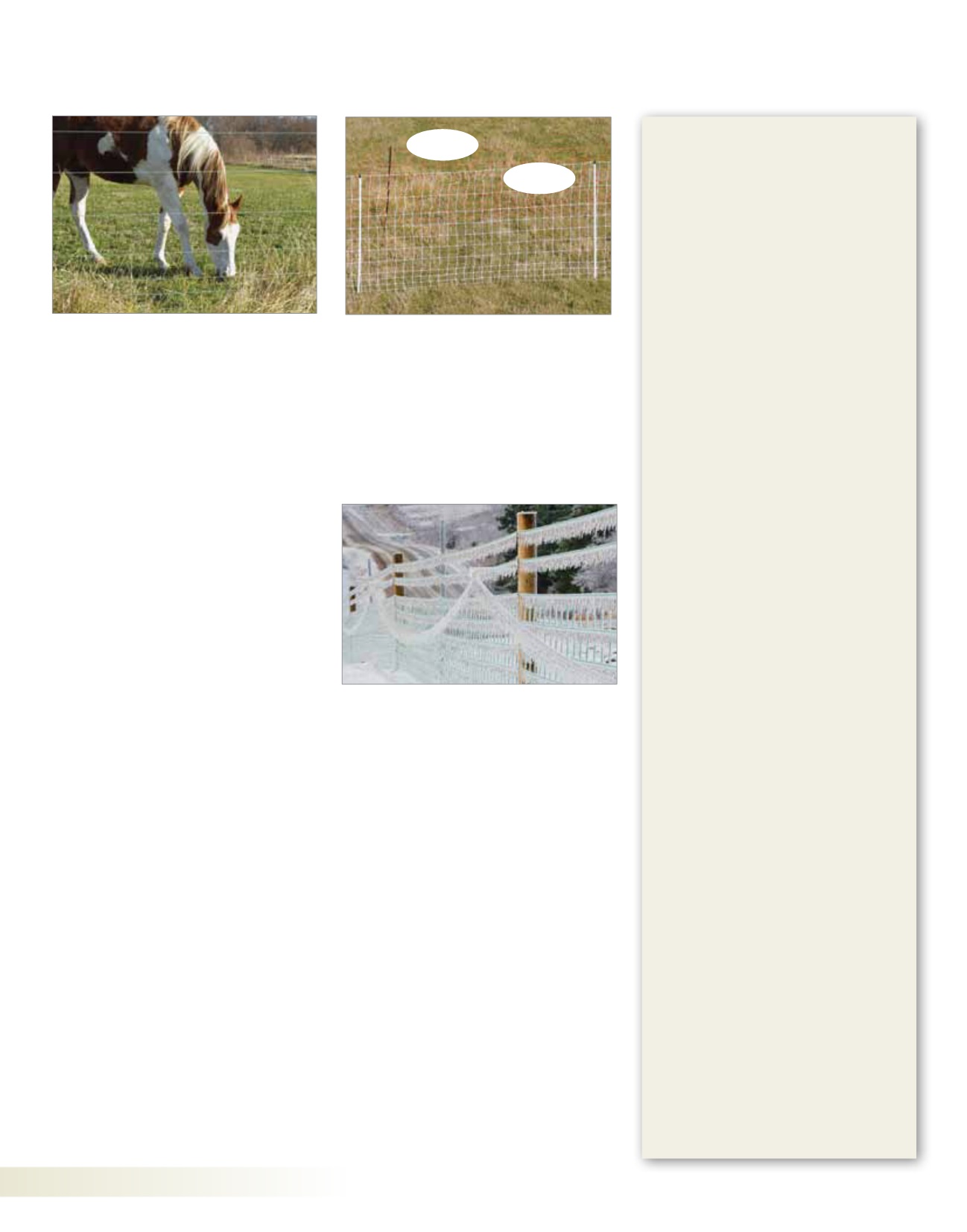
08 BEFORE YOU BUY OR BUILD A FENCE
www.premier1supplies.com •1-800-282-6631
Before you buy or build a fence…
Q. Will heavy snow or ice occur?
A.
Enough ice can bring down the
strongest power lines so all fences
are vulnerable to it. Some cope better
than others.
The question is—are your animals
likely to challenge the fence before
the ice melts?
Q. What’s the cost if the fence fails?
A.
The higher the potential cost (in time
and money) of a failure, the more
reliable the fence design should be.
Examples:
• Along public highways
. In some
states the landowner is liable for
damages to vehicles and humans.
•
Around stored feed.
If animals
gorge on grain, death may occur.
•
High-value protection,
e.g.
crops, gardens, orchards; or
livestock from predators.
•
Fences with animals on
both sides.
Mix-ups are
time-consuming and costly.
Neighborhood relations can be
strained. Lawsuits may occur.
Fence visibility is critical for animals that move at
high speed (e.g. horses, deer) and/or have poor depth
perception.
HT wire fences like these are not easily
seen and therefore not advised for horses.
Q. How visible should a fence be?
A.
It depends upon the species. Horses,
deer and antelope move at high speed
and have restricted color perception
(compared to humans). They often
fail to see small or dark fence wires
like HT wire, MaxiShock and some
polywires and charge through them.
That’s why it’s wise to include one
or more strands of bicolored rope or
tape (both highly visible) in fences.
Q. Are dry periods common?
A.
Electric fences typically rely on soil
moisture as a conductor. When the
soil is dry or covered in dry snow,
normal electric fences and low-
impedance energizers may not work
effectively to keep animals in/out.
Solutions for this are:
1. Use a wide-impedance energizer.
They’re less affected by dry soil.
2. Integrate ground-return wires
(connected to energizer’s negative
terminal) into the fence. Animals
must touch 2 strands (a negative
and a positive) but it works well.
Q. How visible is Premier’s white/
black net (and now also yellow)
compared to orange or red nets?
A.
White/black provides contrast against
all backgrounds 24/7 and is therefore
more visible to humans and animals.
Orange/red is visible to humans
in daylight but not at night.
To
most animals these 2 colors appear
dark gray in daylight and are nearly
invisible at night.
Yellow is most visible during the
day and light grey at night.
Q. Why are lane and corral fences
considered special?
A.
Animals are often forced into contact
with these fences. Therefore they
need better visibility, more strength
and, if possible, no energized wires.
We cannot stress visibility enough. Even in daylight
a black/white net color is significantly more visible
than orange or red against most backgrounds.
Orange net
Premier’s
white net
Some advice for folks new to
farming and fencing—
Fences…
• Most fences will eventually need
maintenance and repairs.
• Electrified fences should never touch
conductive metal. If they do, fence
voltage will be reduced.
• Animals and poultry will test or
chew on nonelectrified fences.
• When the soil is dry, fences that
rely on the soil to carry the pulse to
ground rods do not work as well.
Energizers, batteries & accessories…
• Repeatedly going below a 40%
charge on a lead-acid battery will
reduce its ability to hold a charge.
• You need special insulated wire to
carry power to a fence, not just any
insulated wire from the store.
• You need a ground rod to connect
to the negative terminal of the
energizer.
Don’t connect the
energizer’s negative terminal to the
other end of the netting.
• The end clip of the netting can’t and
shouldn’t ever be plugged into an
AC outlet.
Posts…
• You will need a strong, stable post
to support netting at each corner or
major change of direction.
•
Never use a hammer to drive
normal
netting posts into the ground
.
Instead drill pilot holes.
• We think
our
new drivable
posts
are superior to both double and
single spike posts—
because you tap
them into hard soil with a hammer
(preferably a dead-blow hammer).
Animals…
• Will at some time get sick or hurt.
• You cannot save every animal that
gets sick or injured.
• If you own animals you will need
a veterinarian at some point. So
establish that relationship
before
the
emergency occurs.
• You must train animals to know and
respect electrified fences.
• Animals can get caught in nearly any
type of fence and become injured
when they do.
• If you do not keep a fence energized
at all times, your animals will lose
fear of it. Then they will go over or
through it. Retraining is difficult.









